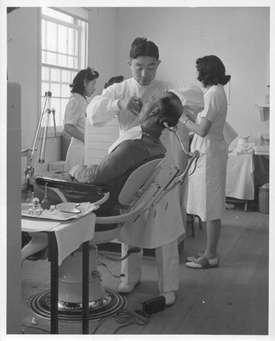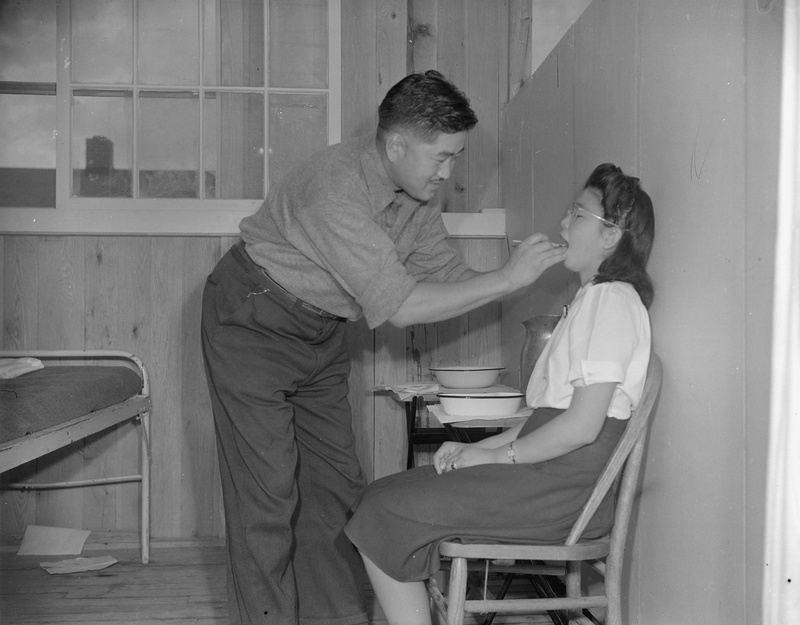The late Hiroshi Kashiwagi’s short play Laughter and False Teeth remains a staple of Asian American Theatre. In an interview with Emiko Omori in her landmark film Rabbit in the Moon, Kashiwagi explained the real-life background of the piece in the experience of his mother at the time of mass removal:
“she had to go to camp without teeth. And she was only, as I say, about forty. And she had to go like this all the time. [Covers mouth with hand] And it must have been miserable for her. God, she never got over this hiding her mouth. And then in camp, they wouldn’t make her false plates. And I wrote about this in the play, you know, Laughter and False Teeth. But there was a dental technician who made plates -- [laughs] -- illegally, I guess, and finally she was able to get her teeth that way, by bribing this guy. But for a woman to go that way, and then to go to mess hall, and gum her food, it must have been awful for her.’1
The poignant story of Kashiwagi’s mother and her teeth was unfortunately far from the only one. The poor state of dental treatment in camp - like that of medical treatment overall - underlines the many failures of the U.S. government to ensure the inmates’ safety and comfort. While in some cases the camps enabled Japanese Americans living in rural areas to obtain medical treatment to which that they would have not otherwise had access, it did little to improve the lives of the confined.

Although the psychological trauma triggered by the camps experience has been examined in studies such as Janice Tanaka’s wonderful film When You Are Smiling, that failures of medical treatment that resulted in continuing disabilities or death form an element of camp life that historians need to take up in greater detail.2 Camp medical procedures, like many services, were provided and controlled by the federal government through the United States Public Health Service. According to an announcement issued by the WCCA on July 21, 1942, the U.S. Public Health Service was ordered to assist in caring for those in camp and establish regulations of dental procedures.
While official policies were designed to ensure that a minimum of care was being administered by officials, the reality was far harsher. From the opening day of the assembly centers, Louis Fiset asserts in his article on camp medicine, camp dentists saw on average 300 individuals per day.3 The procedures themselves were limited by army guidelines to the most simple treatment; dental work was limited to “emergency and preventive dentistry” and did not include any restorative work,” including bridge work, fitting dentures “and the like.”4 The difference between these two forms of treatment is simple: approved dental work was strictly limited to teeth removal, and practitioners had few resources to do much else.
The history of dentistry in camp also sheds light on a greater history of Japanese Americans in dentistry. Like other Japanese Americans in higher education, a number of Japanese American dentists trained in the 1910s and 1920s at respected dental schools such as the College of Physicians and Surgeons - the precursor to University of the Pacific’s Dental School until 1962 - in San Francisco.
In their May 1942 alumni magazine Contact Point, the Dental School issued a statement on behalf of Japanese American alumni regarding their removal, stating “we hope, and truly believe, the that the inconvenience and discomfort is understood and that such plans will be temporary.”5
In subsequent issues, University of the Pacific proudly noted the work of alumni in concentration camps, such as Dr. Masato Okuda (’41) from San Francisco who became the first at Amache camp to join the U.S. military.6 At the same time, they mourned the deaths of alums such as Dr. Tatsuo Yamamoto (’06), who had resettled in Des Moines after working at Gila River camp.7

While brief in detail, these stories of alumni in camp both shed light on the success of Japanese Americans becoming dentists in the prewar years, but exposed white alumni to the fact their classmates were imprisoned. Whether they understood the implications, however, is less clear. More recently, Contact Point has featured the work of alum Masako Moriya Wiggans (’37), noting her work with the Gila River Dental Office and later as a dental assistant in the Women’s Army Corp.8
In contrast, Japanese American dental students also faced troubles in leaving school. The USC School of Dentistry was the sole school on the West Coast that refused to give transcripts to Japanese American students relocating due to the incarceration. In response to demands from the National Student Relocation Council to send transcripts to Japanese American students before their incarceration, Dean Ford of the USC Dental School stated it did not care to assist “prisoners of war” in the camp.9 Even after Dean Monroe Deutsch of UC Berkeley argued to USC President von Kleinsmid that transcripts sent to Japanese American students was being done by other West Coast schools, von Kleinsmid remained adamant in the school’s decision to refuse transcripts. Even when USC sent transcripts, they denied academic credits for the 1941 - 1942 academic year.
While finding dentists among the “evacuated population” was not difficult, justifying purchases for usable equipment was. In a December 1942 budget report for Manzanar camp, the amount listed as spent on dental and ophthalmology equipment was half that spent on burials.10 The budget situation would reverse later in 1943, when the camp dental clinic was fully established. By this time, the camp dental clinic was able to accommodate most of the confined.
Between 1943 and 1944, the Dental department saw over 15000 cases among the inmates of Manzanar, reaching a frequency of almost 2 per individual.11 Equipment requested according to camp budgets included drills, curettes, and clamp rongeurs for oral surgery. For dentures, when not informally made under the table, standard camp policy was to contract out to labs in nearby cities. For Manzanar, however, a denture program was not established with a lab in Los Angeles until March 1945, months before the camp’s closure.12
What these statistics fail to reveal, however, is what this treatment entailed and whether their health actually improved. One argument can be made that the psychological effects of incarceration had a cyclical effect. The stress of camp - combined with poor dental care - easily could lead to harmful infections such as necrotizing ulcerated gingivitis, more popularly known as “trench mouth.”
Even after leaving camp, Japanese Americans faced continued discrimination that extended into medical care. In an August 1943 issue of the Rocky Mountain Shimpo, it was reported that the Wisconsin State Dental society advocated against hiring Japanese American dentists, lab technicians, or hygenists. Arguing they are “not needed to fill any shortage” and would “be detrimental to the health of our patients,” the State Dental society refused to see Japanese American dentists as equals and rehashed white nativist complaints immigrants taking jobs.13 For Japanese Americans looking for medical treatment, racial tension was a threat that could lead to denial of treatment or, worse, malpractice.
In sum, while the Public Health Service made attempts to curtail mass outbreaks and pandemics within the barbed wire fences during World War II, its officials did little to ensure safe treatment for the confined. As in the case with Kashiwagi’s mother, poor access to dental care and education can have severe effects on diet - specifically by resorting to gumming food without dentures - in addition to mental health. Dental infections, when left untreated, can cause extreme pain and potentially have lethal consequences. Like general medicine in the camps, dentistry in camp was inadequately supplied and restricted by regulations. When taken into account, the issue of dental care is one of many factors that made the camp experience traumatizing and merits further study by historians.
Notes:
1. Interview with Hiroshi Kashiwagi, October 1, 1942. Courtesy of Densho Digital Repository.
2. Gwenn M. Jensen’s article for Discover Nikkei, the Densho Encyclopedia entry on camp medicine, and Louis Fiset’s article on camp medicine are the primary articles written thus far on medical treatment.
3. Louis Fiset. ”Public Health in World War II Assembly Centers for Japanese Americans.” Bulletin of the History of Medicine 73, no. 4 (1999): 565-84
4. “WCCA: Dental Procedures.” July 21, 1942.National Archives, San Bruno
5. “The School,”The Contact Point, (May 1942), 86. Courtesy of Dorothy Dechant, University of Pacific.
6. “Alumni News,” The Contact Point, (September 1943), 131. Courtesy of Dorothy Dechant, University of Pacific.
7. “Alumni News,” The Contact Point, (January 1945), 58. Courtesy of Dorothy Dechant, University of Pacific.
8. “Old School: Masako Moriya Wiggans.” Contact Point.
9. “The National Student Relocation Council.” 1944. BANC MSS 67/14 c, folder T2.00. JERS Collection, Bancroft Library, 25.
10. The amount spent on Burial Services amounted to $1000 dollars for 1942, with dental and ophthalmological equipment rentals at $500. “Concerning Proposed Health Budget Third Quarter, 1943.” December 28, 1942. BANC MSS 67/14 c, folder O2.601. JERS Collection, Bancroft Library.
11. “Memo to Kelly Shelton, Budget 1945, Manzanar War Relocation Center.” January 5, 1944. BANC MSS 67/14 c, folder O2.601. JERS Collection, Bancroft Library.
12. “Memorandum: Funds for Dental Prosthesis.” March 7, 1945. BANC MSS 67/14 c, folder O2.601. JERS Collection, Bancroft Library.
13. “Wisconsin Dentists Frown on Employment of Nisei Evacuees” Rocky Mountain Shimpo, August 20, 1943.
*This article is also published by NikkeiWest.
© 2019 Jonathan van Harmelen






